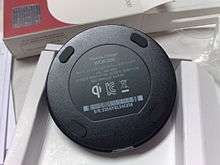Qi (standard)
|
The Qi logo, consisting of a lowercase "q" with a semicircle-esque "i" with a circle on top. | |
| Status | Active |
|---|---|
| Year started | 2008 |
| First published | 2008 |
| Latest version | 1.2.2 |
| Organization | Wireless Power Consortium |
| Committee | Wireless Power Consortium |
| Domain | Inductive charging |
| License | Open standard |
| Copyright | Logo and trademark |
Qi (pronounced CHEE;[1] IPA: /tʃiː/, meaning "natural energy") is an open interface standard developed by the Wireless Power Consortium for inductive charging over distances of up to 4 cm (1.6 inches).[2] The system uses a charging pad and a compatible device, which is placed on top of the pad, charging via resonant inductive coupling.[3]
Mobile device manufacturers that are working with the standard include Asus, HTC, Huawei, LG Electronics, Motorola Mobility, Nokia, Samsung, BlackBerry, and Sony.[4] According to a list of Qi devices by Qi Wireless Charging,[5] July 14, 2016 there were over 140 smartphones, tablets and other devices which can be charged wirelessly with Qi.
Features and specifications
Under the Qi specification, "low power" for inductive transfers denotes power deliveries below 5 W. Systems that fall within the scope of this standard are those that use inductive coupling between two planar coils to transfer power from the power transmitter to the power receiver. The distance between the two coils is typically 5 mm. It is possible to extend that range to at least 40 mm.[2] Regulation of the output voltage is provided by a digital control loop where the power receiver communicates with the power transmitter and requests more or less power. Communication is unidirectional from the power receiver to the power transmitter via backscatter modulation. In backscatter modulation, the power-receiver coil is loaded, changing the current draw at the power transmitter. These current changes are monitored and demodulated into the information required for the two devices to work together.[3]

The WPC published the Qi low power specification in August 2009.[6] The Qi specification can be downloaded freely after registration.[7] In 2011, the Wireless Power Consortium began to extend the Qi specification to medium power.[8][9] The low-power specification delivers up to 5 W (typically used to charge mobile devices), and the medium-power specification will deliver up to 120 W (typically used to power displays and laptops). In 2015, WPC demonstrated a high-power specification that will deliver up to 1 kW, allowing the powering of kitchen utensils among other high-power utilities.[7]
Adoption
As the Qi standard gains popularity, it is expected that Qi Hotspots will begin to arise in places such as coffee shops, airports, sports arenas, etc.[6] The Coffee Bean and Tea Leaf, a major US coffee chain, will install inductive charging stations at selected major metropolitan cities,[10] as well as Virgin Atlantic Airways, for United Kingdom's London Heathrow Airport[11] and New York City's John F. Kennedy International Airport.[12] Tulsa International Airport has already implemented chargers in half of the airport.[13] Furniture retailer IKEA introduced lamps and tables with integrated wireless chargers for sale in 2015.[14] Also starting in 2015 the Lexus NX will come with an available Qi charging pad available in the center console.[15]
System overview
Devices that operate with the Qi standard rely on electromagnetic induction between planar coils. A Qi system consists of two types of devices – the Base Station, which is connected to a power source and provides inductive power, and Mobile Devices, which consume inductive power. The Base Station contains a power transmitter that comprises a transmitting coil that generates an oscillating magnetic field; the Mobile Device contains a power receiver holding a receiving coil. The magnetic field induces an alternating current in the receiving coil by Faraday's law of induction. Close spacing of the two coils, as well as shielding on their surfaces, ensure the inductive power transfer is efficient.
Base Stations typically have a flat surface—referred to as the Interface Surface—on top of which a user can place one or more Mobile Devices. There are two methods for aligning the transmitting coil (part of the Base Station) and receiving coil (part of the Mobile Device) in order for a power transfer to happen. In the first concept—called guided positioning—a user must place the Mobile Device on a certain location of the Base Station's surface. For this purpose, the Mobile Device provides an alignment aid that is appropriate to its size, shape and function. The second concept—referred to as free positioning—does not require the user to place the Mobile Device in direct alignment with the transmitting coil. There are several ways to achieve free positioning. In one example a bundle of transmitting coils is used to generate a magnetic field at the location of the receiving coil only. Another example uses mechanical means to move a single transmitting coil underneath the receiving coil. A third option is to use a technique called "Multiple Cooperative Flux Generators."[16]

Figure 1-1 illustrates the basic system configuration. As shown, a power transmitter includes two main functional units—a power conversion unit and a communications and control unit. The diagram shows the transmitting coil (array) generating the magnetic field as part of the power conversion unit. The control and communications unit regulates the transferred power to the level that the power receiver requests. The diagram also demonstrates that a Base Station may contain numerous transmitters, allowing for multiple Mobile Devices to be placed on the same Base Station and inductively charge until each of its batteries are fully charged. Finally, the system unit in the diagram comprises all other functionality of the Base Station, such as input power provisioning, control of multiple power transmitters, and user interfacing.
A power receiver comprises a power pick-up unit, as well as a communications and control unit. Similar to the power conversion unit of the transmitter, Figure 1-1 illustrates the receiving coil as capturing the magnetic field of the power pick-up unit. A power pick-up unit typically contains a single receiving coil only. Moreover, a Mobile Device typically contains a single power receiver. The communications and control unit regulates the transferred power to the level that is appropriate for the subsystems (e.g., battery) connected to the output of the power receiver. These subsystems represent the main functionality of the Mobile Device.
See also
- Inductive coupling
- Near field communication
- Open Dots, a competing wireless power standard promoted by the Open Dots Alliance
- PMA / Powermat, a competing wireless power standard promoted by the Power Matters Alliance
- Rezence, a competing wireless power standard promoted by the Alliance for Wireless Power
- WiPower
- Wireless power transmission
References
- ↑ "Wireless Power Consortium". Retrieved November 22, 2015.
- 1 2 "eCoupled Wireless Power Through Granite".
- 1 2 "An introduction to the Wireless Power Consortium standard and TI's compliant solutions" (PDF).
- ↑ "Wireless Power Consortium Members".
- ↑ "List of smartphones, tablets and other devices which support Qi".
- 1 2 "Global Qi Standard Powers Up Wireless Charging".
- 1 2 "Download Wireless Power Specification Part 1".
- ↑ "Medium power extension".
- ↑ "Medium power extension".
- ↑ "Nokia and The Coffee Bean & Tea Leaf® form partnership to introduce wireless charging to cafés across the United States". Nokia. September 5, 2012. Retrieved September 21, 2012.
- ↑ "Nokia and Virgin Atlantic partner to introduce wireless charging to Virgin Atlantic Clubhouse Lounges". Nokia. September 5, 2012. Retrieved September 21, 2012.
- ↑ "Nokia flies Virgin Atlantic on wireless charging". Nokia. September 11, 2012. Retrieved September 21, 2012.
- ↑ citeweb|http://www.tulsaworld.com/site/printerfriendlystory.aspx?articleid=20130331_46_E1_Noonei555542|publisher=Tulsa World|date=March 23, 2013|accessdate=May 28, 2013
- ↑ Brian, Matt. "IKEA will start selling wireless charging lamps and tables". Engadget. Retrieved 1 March 2015.
- ↑ http://www.lexus.com/models/NX-hybrid/features/wireless-charger
- ↑ "Variable Position Wireless Power Transmitter through Multiple Cooperative Flux Generators".
External links
- Qi – official site
- Compatibility check to find out whether your device supports Qi or not
- "Is Qi Ready to Be the Standard for Wireless Power?". Popular Science. Retrieved 2009-08-21.
- Hachman, Mark (2009-08-17). "Wireless Power Spec Nears Completion - News and Analysis by PC Magazine". Retrieved 2009-08-21.
- Schofield, Jack (2009-08-19). "Is there a realistic future for power without wire?". The Guardian. London. Retrieved 2009-08-21.
